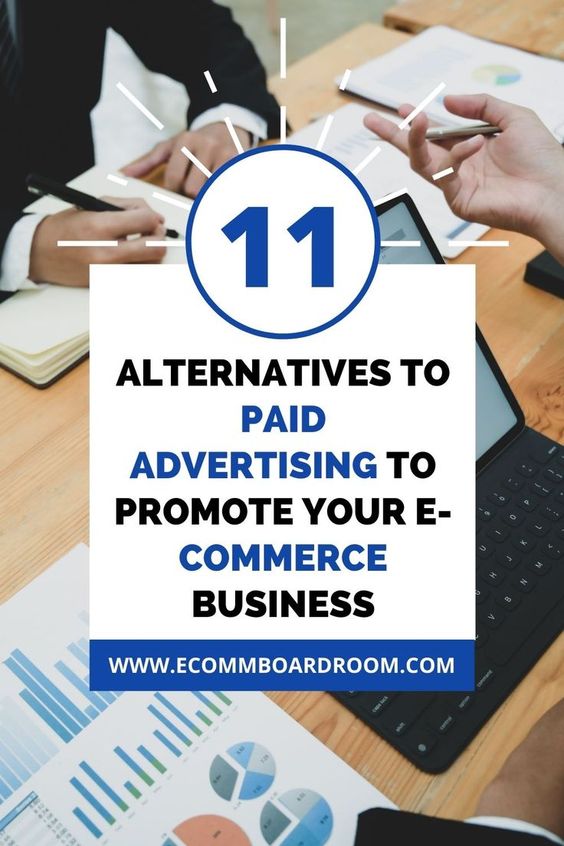Promoting your business can bring new customers in the door and increase your profits. If you’re just starting an online business or you’ve been in business a while, you might have thought about paid ads. But did you know that there are many alternatives to paid advertising?
Paid advertising can be effective, but it’s also expensive. The good news is that you don’t have to fork over a truckload of cash to promote your business.
Many business owners overlook free and low-cost promotion opportunities. The key is to create a foundation for your online presence. Then, you can target the right people without draining your budget.
Here are 11 alternatives to paid advertising to promote your business.
1. Create a Google My Business Profile
When you’re doing ecommerce, you need to have a prominent online presence. What better way to do that than with Google?
Google dominates the search engine market with a whopping 92% of market share. You can tap into that success and gain visibility with the first of our alternatives to paid advertising: creating a Google My Business account.
Keep in mind this is separate from a Google Business Profile you may already have. A Business Profile appears in Google Maps and local search results. However, it doesn’t allow you to manage the information it displays or the reviews it collects.
But with Google My Business, you can customize, manage, and enhance your Google Business Profile.
2. Offer Local Delivery
Even though you’re an online business, I bet there’s a local market for your products. More and more, people are opting to buy from independent companies over the big online retailers. Offering local delivery can help you capitalize on the trend.
Consider a personal delivery when a local customer orders something from your online store. It’s a thoughtful and simple way to go the extra mile to attract and retain local customers.
3. Do an Expert Roundup
Blogging is an easy way to increase brand awareness. Businesses that prioritize blogging see an ROI that’s 13-times higher than those that don’t.
Creating a blog post can be time consuming. But that’s the beauty of the next of our alternatives to paid advertising: the expert roundup post.
Find experts on a topic that relates to your product. Then ask for contributions from those bloggers or experts. For example, they might contribute a tip, recipe, or story.
Either way, you’ll end up with an article that’s packed full of value for your readers. And the contributors will want to share your article with their readers, so you automatically increase the number of people that see your post.
4. Drive Traffic with Guest Posts
The ultimate goal is to drive traffic to your ecommerce site. Blogging is an excellent way to gain free traffic with inbound marketing, but the results can take time. One shortcut is to write a guest post for another blogger.
Seek out bloggers and businesses with a similar audience to your own. You don’t want someone you’re in direct competition with, but plenty of complimentary services and markets exist.
Connect with another blogger and offer to write an article for their site. Make sure the topic is related to your business and also something their audience will love. It’s a quick way to gain additional traffic and boost search engine optimization (SEO).
5. Ask for Product Reviews
Study after study shows that reviews are a driving factor for people to purchase a product online. Customers want to know what others think about the product. Use this to your advantage by asking for product reviews.
Reach out to bloggers and potential customers to get the ball rolling. Offer them a free product in exchange for leaving an honest review.
Chances are you have great merchandise and just need some momentum to get the word out. This is an excellent way to let your products speak for themselves.
6. Start an Affiliate Program
An affiliate program is one of my favorite alternatives to paid advertising, and can affordably drive more traffic and increase sales for your ecommerce business. The best part? It doesn’t cost you anything upfront.
With affiliate marketing, you establish a relationship with a publisher. That person could be a blogger or another ecommerce store owner. They promote your products and earn a commission on every sale.
It lets you tap into the publisher’s influence and web traffic to draw in new business.
7. Invest in a High-Quality Infographic
SEO is a long game. It could take months or years to build enough clout to show up on the first page of Google’s search results.
But a high-quality infographic can increase backlinks and domain authority to help you get there faster.
Unless you’re a graphic designer, you’ll likely have better results hiring a professional to create it for you. Identify the information you’ll include in the graphic and provide examples of what you might want it to look like.
If it’s good quality with compelling information, blogs and news outlets could feature it on their site and provide a link back to your site.
8. Get Found in Google Search
For online businesses, more than a third of revenue comes from search engine results pages. Because Google has the lion’s share of search traffic, you want to make sure customers can find your business in Google’s search results.
If you haven’t already, submit your sitemap to Google Search Console. This helps Google speed up the indexing of your site.
Other ways to get found in Google search include creating a keyword strategy, filling out your site’s meta tags, and making sure your site looks good on mobile.
9. Create a Presence on Social Media
You’re probably already on social media in some way, shape, or form. But are you really present?
If you post random links and an occasional mention, your social presence needs some work. Don’t worry: you can do it even without the budget to hire a social media manager.
First, ask yourself why you’re on social media in the first place. Then, set concrete steps in place that support your goal.
For instance, if you want to increase brand visibility, create a plan to make it happen. You might give your social media presence some personality, fine-tune your profile, tag others to amplify your content, and use relevant hashtags to make your posts searchable.
10. Create Quizzes to Drive Sales
Quizzes are engaging. They can create an in-store retail experience for your online store and boost customer confidence to drive sales.
Consider your products and which customers are drawn to each one. Create a quiz that asks questions about a customer’s preferences, challenges, desires, and more – then match the results with a buyer profile to give personalized product recommendations.
11. Get in a Gift Guide
Gift guides are the perfect place to showcase your products. Most gift guides cater to a specific audience. It can be based on occupation (“best gifts for women who work from home”), relationships (“best gifts for dad”), or around a shared interest (“gifts for animal lovers”).
Because they’re so specialized, you must be very targeted when pitching your products for gift guides.
Making a list of possible sites or magazines you’d like to be featured in is a good starting point. Then, check to see which of those have gift guides.
Make sure to include details and images for one to five products. Giving the publisher a few options means they’re more likely to include you in their gift roundup.
What Alternatives To Paid Advertising is Best for Your Business?
Free and low-cost alternatives might take a little more effort to promote your business, but the results can be more than worth it.
Not every promotional method will work for every ecommerce business. The key is to tune into your ideal customer and think about what will appeal to them.
Increasing your chances to get found on Google is good for nearly every business, no matter the product you’re selling. But if your audience is less likely to engage on social media, don’t spend as much time promoting that way.
It might take some trial and error to figure out what works for you. But when you really know your market base, marketing is easier. You’ll find ways to connect with them, and they’ll find a way to spend money.

This was a guest post by Amy Beardsley
Amy Beardsley is a freelance content marketing writer and money expert. At Early Morning Money, she helps women start and grow side hustles to achieve financial independence. Want to know how to put more cash in your pocket every month? Get a free four-page guide to side hustle ideas and start today!


